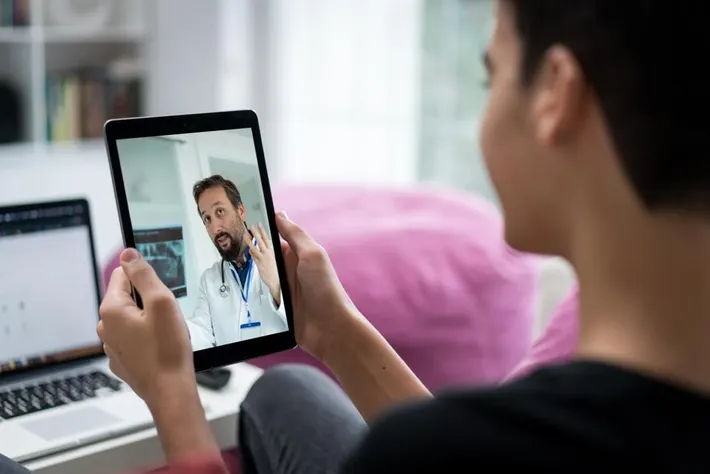Introduction
The healthcare landscape has undergone significant transformation in recent years, and at the forefront of this evolution is telehealth. Defined as the use of digital communication technologies to provide healthcare remotely, telehealth has revolutionized patient-provider interactions, enabling seamless access to care without the need for in-person visits. The rise of telehealth, accelerated by the COVID-19 pandemic, has paved the way for a more efficient and patient-centric healthcare delivery model. In this guide, we’ll explore what is telehealth, its benefits, applications, challenges, and what the future holds for this transformative approach.
What is Telehealth?
Telehealth encompasses a wide array of services that leverage technology to provide healthcare. This can include live video conferencing for consultations, remote patient monitoring via wearable devices, and secure messaging systems for continuous communication. The World Health Organization (WHO) defines telehealth as:
“The delivery of healthcare services, where patients and providers are separated by distance. It uses information and communication technologies (ICT) for the exchange of information for diagnosis, treatment, and prevention of disease.”
Telehealth vs. Telemedicine
While the terms are often used interchangeably, there are subtle differences:
- Telemedicine: Focuses on clinical services such as remote diagnosis, treatment, and consultations.
- Telehealth: A broader term that includes telemedicine but also incorporates health education, public health initiatives, and administrative tasks.
Core Technologies in Telehealth
- Video Conferencing: For real-time consultations.
- Store-and-Forward: Sharing diagnostic data like X-rays or photos.
- Remote Patient Monitoring (RPM): Devices that track and transmit health data such as heart rate or blood pressure.
- Mobile Health (mHealth) Apps: Apps for tracking health metrics and managing medications.
The Growth of Telehealth
Market Expansion
Telehealth has grown exponentially, especially in recent years.
- According to a McKinsey report, telehealth usage surged 38 times during the COVID-19 pandemic, rising from 11% in 2019 to 43% in 2021.
- The global telehealth market size was valued at $83.5 billion in 2022 and is projected to reach $455 billion by 2030, growing at a CAGR of 24% (Grand View Research).
Adoption Across Demographics
Telehealth adoption has been robust across different age groups:
- Millennials (53%) and Gen Z (52%) are the most frequent users, citing convenience.
- Older adults (65+) show increasing adoption due to chronic disease management programs.
Impact of COVID-19
The pandemic highlighted telehealth’s importance:
- 76% of hospitals in the U.S. now connect patients with physicians remotely (American Hospital Association).
- Telehealth visits in Medicare increased from 840,000 in 2019 to over 52 million in 2020.
Benefits of Telehealth
1. Accessibility
Telehealth bridges the gap for patients in rural or underserved areas.
- Nearly 57 million Americans live in Health Professional Shortage Areas (HPSAs) where telehealth provides a lifeline for access to specialists (Kaiser Family Foundation).
2. Time and Cost Savings
- The average cost of a telehealth visit is $50 compared to $176 for in-person urgent care (American Journal of Managed Care).
- Patients save 37 minutes on average per appointment by eliminating commute times.
3. Chronic Disease Management
Remote monitoring devices allow continuous tracking of vital signs for patients with diabetes, hypertension, or heart disease.
- RPM has been shown to reduce hospital readmissions by 38% for heart failure patients (American Heart Association).
4. Safety During Health Crises
Telehealth minimizes the risk of spreading infectious diseases like COVID-19, allowing patients to receive care safely from home.
5. Increased Provider Efficiency
Providers can see 2-3 more patients per day with telehealth, streamlining workflows without compromising care quality.
How Does Telehealth Work?

Telehealth services are delivered through the following key methods:
1. Virtual Consultations
Patients connect with healthcare providers using secure video conferencing tools. Common conditions treated include:
- Migraines
- Skin issues
- Respiratory infections
- Anxiety and depression
Before the session, patients may need to complete online forms or check their device compatibility.
2. Remote Patient Monitoring (RPM)
RPM devices like blood glucose monitors or smartwatches collect and transmit health data. Providers can intervene in real-time if critical thresholds are exceeded.
3. Store-and-Forward Technology
This allows providers to review diagnostic data, such as CT scans or pathology slides, sent electronically.
- Example: A rural clinic sends a digital X-ray to a radiologist in another state for analysis.
4. Patient Portals and Apps
Secure platforms let patients:
- Book appointments
- Access lab results
- Message providers
5. Telehealth for Provider Collaboration
Specialists can offer remote consultations to primary care doctors, improving diagnostic accuracy and treatment plans.
Applications of Telehealth
1. Mental Health Counseling
Telehealth has been a game-changer in mental health:
- Virtual therapy sessions increased by 54% during the pandemic.
- Common treatments include cognitive-behavioral therapy for anxiety and PTSD.
2. Chronic Disease Management
Patients with diabetes can use telehealth for regular check-ins, ensuring blood sugar levels remain controlled.
- Real-time glucose monitors have reduced diabetic complications by 32% in RPM programs.
3. Post-Surgical Follow-Ups
Virtual check-ins allow patients recovering from surgery to consult with their providers without traveling.
4. Preventive Care
Telehealth platforms provide resources like dietary advice, exercise tracking, and vaccination reminders, empowering patients to take control of their health.
Challenges of Telehealth
Despite its advantages, telehealth faces several barriers:
1. Digital Divide
- 21 million Americans lack broadband access, limiting their ability to use telehealth services (FCC).
- Older adults may struggle with the technology required for virtual visits.
2. Reimbursement Policies
Insurance coverage for telehealth varies widely. While Medicare and Medicaid expanded coverage during the pandemic, many private insurers lag behind.
3. Diagnostic Limitations
Certain conditions require in-person evaluation for physical exams, imaging, or lab tests.
4. Privacy Concerns
With data breaches on the rise, ensuring secure communication is vital. HIPAA-compliant platforms mitigate these risks but require constant monitoring.
The Future of Telehealth
Telehealth’s trajectory suggests exponential growth, with emerging technologies and policy reforms playing critical roles. Here’s a glimpse into what the future holds:
1. Artificial Intelligence (AI) Integration
AI-powered tools are revolutionizing telehealth by enhancing diagnostic accuracy and streamlining workflows.
- AI chatbots like Babylon Health assist patients in triaging symptoms before connecting with a provider.
- Machine learning algorithms analyze patient data from wearable devices to predict potential health risks, such as heart attacks or strokes.
2. Expansion of Remote Patient Monitoring (RPM)
The RPM market is expected to grow to $175 billion by 2027 (Allied Market Research). Advanced wearables will monitor vitals, medication adherence, and rehabilitation progress in real-time, reducing hospital readmissions.
3. Telehealth and 5G Networks
The rollout of 5G will eliminate latency issues in telehealth services, enabling smoother video consultations and faster data transmission. This is particularly critical for rural areas where connectivity has been a barrier.
4. Personalized Telehealth Services
Telehealth is moving toward precision medicine by integrating genomics and AI to tailor treatment plans to individual patients.
- Example: Apps like Invitae assess genetic data to offer personalized care recommendations.
5. Virtual Reality (VR) and Augmented Reality (AR)
These technologies are being explored for use in:
- Physical Therapy: VR environments guide patients through rehabilitation exercises.
- Surgical Training: AR allows medical students to practice procedures in simulated environments.
- Mental Health Therapy: VR is used for exposure therapy to treat PTSD and phobias.
6. Policy Reforms and Global Adoption
Telehealth’s expansion will be supported by evolving reimbursement policies, cross-border telemedicine agreements, and regulatory frameworks. Countries like India and Brazil are rapidly adopting telehealth to address their healthcare challenges.
Global Trends in Telehealth
United States
- Telehealth Utilization: Post-pandemic, over 80% of healthcare providers in the U.S. continue to offer telehealth services (American Telemedicine Association).
- Medicare Policies: Reimbursement for telehealth services expanded significantly, with over 250 telehealth codes covered as of 2024.
Europe
- Countries like Denmark and the Netherlands have integrated telehealth into their public healthcare systems.
- eHealth Applications: Remote consultations are used for managing chronic diseases such as diabetes and COPD (chronic obstructive pulmonary disease).
Asia-Pacific
- China and India are leading telehealth adoption in response to their vast rural populations.
- Telemedicine Platforms: Ping An Good Doctor (China) and Practo (India) are key players in virtual healthcare delivery.
Africa
- Telehealth is bridging gaps in regions with severe healthcare shortages.
- Mobile health initiatives provide prenatal care and HIV management through SMS and voice calls.
Real-Life Case Studies of Telehealth Success
1. Chronic Disease Management in Rural Appalachia
In the United States, the University of Kentucky implemented an RPM program to manage diabetes in underserved rural communities.
- Outcome: Hemoglobin A1c levels dropped by an average of 1.7% within six months, reducing complications and hospitalizations.
2. Telepsychiatry for Veterans
The U.S. Department of Veterans Affairs (VA) launched a telepsychiatry initiative to address mental health challenges in veterans.
- Impact: Over 500,000 veterans accessed mental health services virtually in 2021, reducing suicide rates by providing timely interventions.
3. COVID-19 Remote Care in Singapore
Singapore’s Ministry of Health implemented telehealth platforms during the pandemic to manage mild COVID-19 cases at home.
- Result: Over 80% of COVID-19 patients were monitored remotely, reducing the burden on hospitals.
4. Telehealth for Prenatal Care in Africa
In Kenya, the MomConnect program uses SMS to provide expectant mothers with health information and connect them with local clinics.
- Outcome: Maternal mortality rates dropped by 20% in participating regions.
Addressing Challenges in Telehealth Adoption
Despite its promise, telehealth faces significant hurdles:
1. Internet Accessibility
- Globally, 2.7 billion people still lack access to the internet (International Telecommunication Union). Expanding broadband coverage is critical for telehealth’s success.
2. Provider Training and Adoption
Healthcare providers require training to effectively use telehealth platforms. The American Medical Association (AMA) emphasizes integrating telehealth modules into medical education.
3. Equity and Inclusivity
Disparities in digital literacy and access to devices can exclude vulnerable populations. Telehealth programs must address these gaps through community outreach and subsidized technology.
The Role of Telehealth in Preventive Care
Preventive care is a growing focus area for telehealth. By promoting early interventions, telehealth reduces the long-term cost of care. Examples include:
- Wearable Tech: Devices like Fitbit and Apple Watch monitor activity levels, heart rate, and sleep patterns to encourage healthier lifestyles.
- Nutrition and Weight Management: Telehealth platforms like Noom provide personalized coaching for weight loss and diabetes prevention.
- Vaccination Campaigns: Virtual consultations help educate patients about immunizations, addressing vaccine hesitancy.
How to Choose a Telehealth Provider
Patients should consider the following factors when selecting a telehealth provider:
- Specializations Offered: Does the platform cater to specific conditions (e.g., mental health, chronic disease management)?
- Technology Requirements: Ensure compatibility with your devices and internet connection.
- Insurance Coverage: Check if your insurer reimburses telehealth services.
- User Reviews: Look for platforms with high ratings for ease of use and provider responsiveness.
The Bottom Line
Telehealth has revolutionized healthcare by making it more accessible, efficient, and patient-centric. Its integration into global healthcare systems is inevitable, with advancements in AI, 5G, and wearables propelling its growth. However, addressing challenges like internet access, reimbursement policies, and equity will be key to ensuring its long-term success.
As telehealth becomes the norm, patients and providers alike must adapt to this new paradigm, embracing its potential to transform healthcare delivery worldwide. Contact us for more info!




